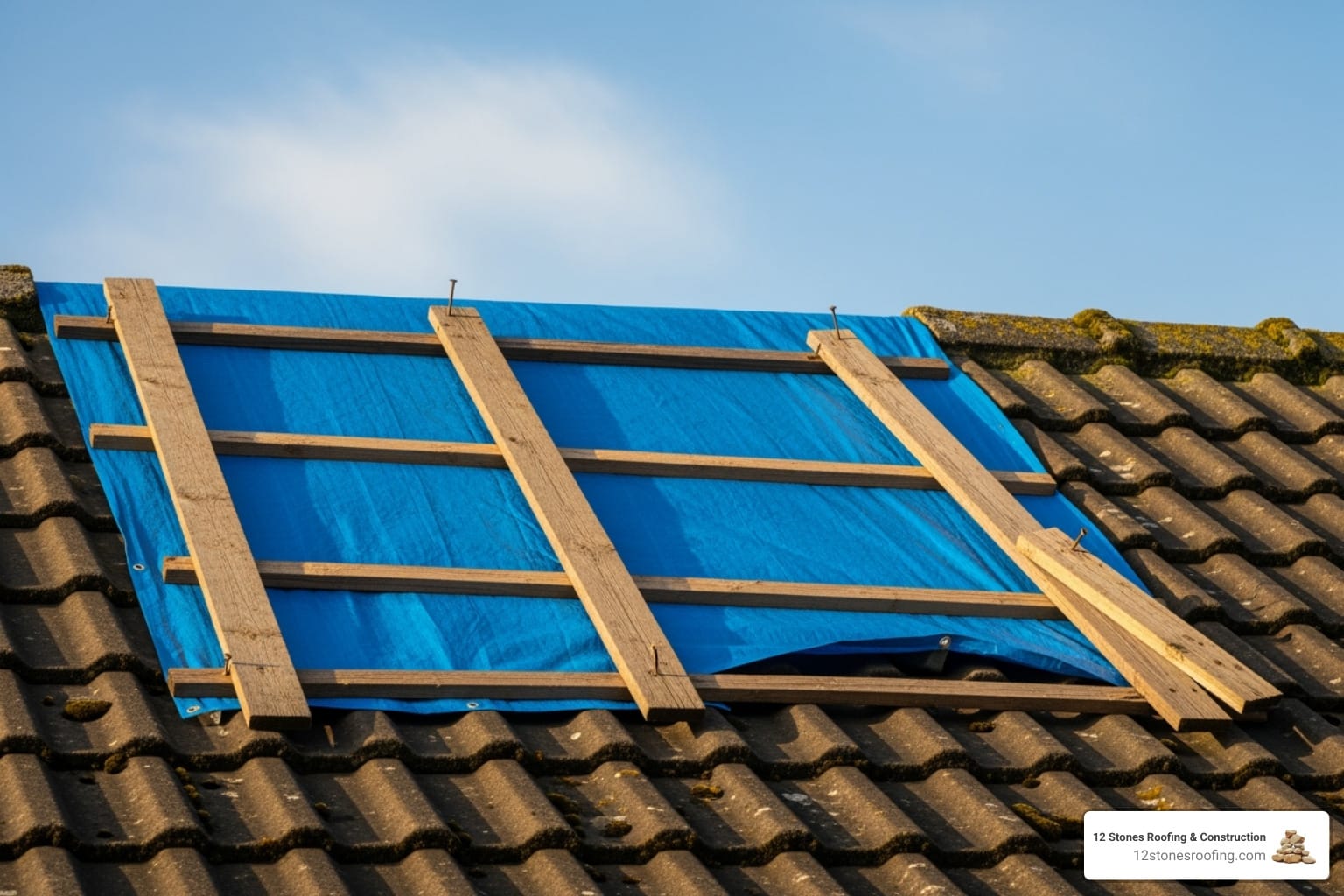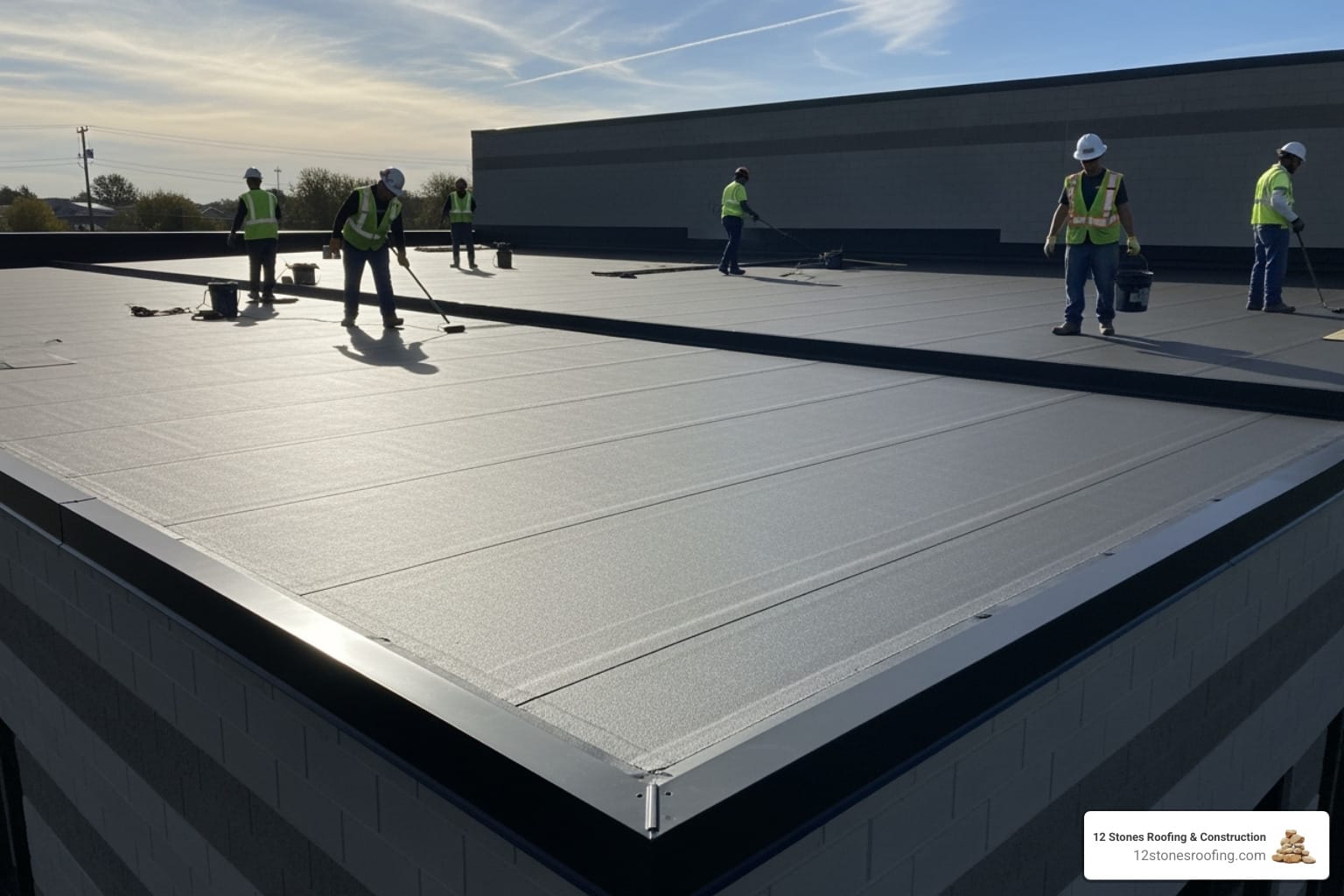Fiberglass Laminate Shingles: Data-Backed Guide for Pasadena, TX Homes
Fiberglass laminate shingles are the dominant premium asphalt shingle for U.S. homes, delivering 30–50-year lifespans, up to 130 mph wind warranties, and Class A fire ratings. For Pasadena, TX roofs exposed to Gulf Coast heat, wind, and hail, laminated fiberglass construction is the most durable, cost-efficient choice. Start with guidance from a trusted Pasadena roofing contractor to compare systems, warranties, and total lifecycle cost.
Fiberglass laminate shingles are a premium type of architectural asphalt shingle, constructed with multiple layers of fiberglass mat bonded together. This creates a thicker, more durable roofing material than traditional single-layer shingles. For Pasadena homeowners facing intense Gulf Coast weather, choosing the right shingle is critical. The laminated architectural style has become the premium standard for residential asphalt shingle roofing installations, offering superior protection and longevity.
Understanding the key differences between laminate shingles and their single-layer counterparts, 3-tab shingles, is the first step in making a smart investment for your home.
Key Differences Between Shingle Types:
| Feature | Laminate Shingles | 3-Tab Shingles |
|---|---|---|
| Lifespan | 30-50 years | 20-25 years |
| Wind Resistance | Up to 130 mph | Lower (60-70 mph) |
| Cost per sq. ft. | $4.00 – $8.50 | $3.50 – $5.00 |
| Appearance | Dimensional, textured | Flat, uniform |
Most modern asphalt shingles use a fiberglass base for its superior fire resistance, moisture protection, and lighter weight compared to older organic mats. The wrong shingle choice can lead to costly repairs, while the right one can protect your home for decades. This guide breaks down exactly what you need to know to choose the right shingle for your home—without the confusing industry jargon.
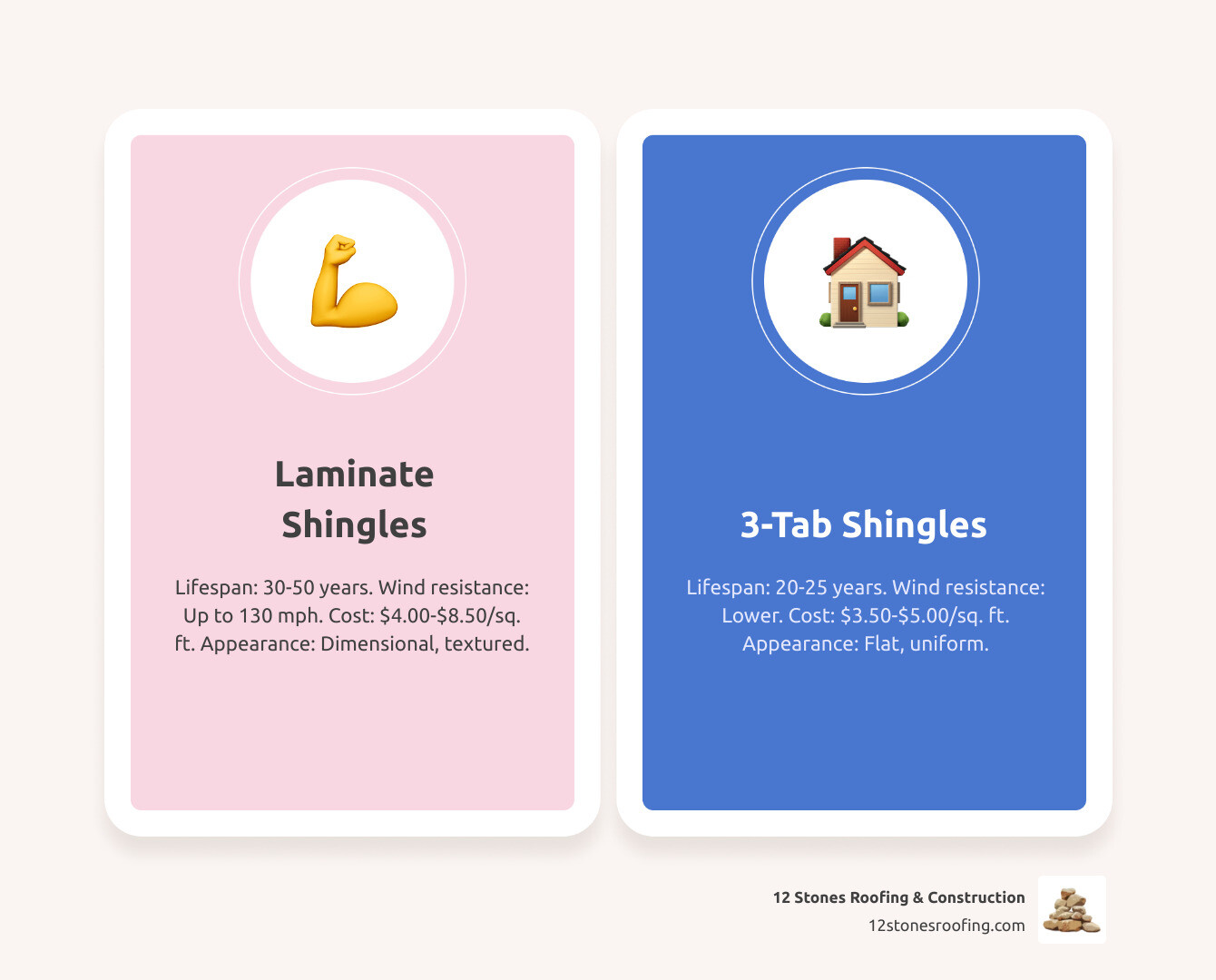
Decoding the Shingle: What Are Fiberglass and Laminate?
When you hear “fiberglass laminate shingles,” you’re looking at one product with two key features. The “fiberglass” refers to the mat that forms the shingle’s foundation, while “laminate” describes its multi-layered construction. In short, all laminate shingles are fiberglass shingles, but not all fiberglass shingles are laminates.
A basic 3-tab shingle uses a single, flat layer of fiberglass mat. Fiberglass laminate shingles—also called architectural or dimensional shingles—stack two or more layers together. This creates a thicker, tougher, and more visually appealing product.
The Anatomy of a Modern Shingle
Every modern asphalt shingle is built from the same core components:
- Fiberglass Mat Base: This woven layer provides a strong, stable skeleton that doesn’t rot or absorb water. It’s a significant upgrade from the old paper-based organic mats. For a technical deep dive, Owens Corning’s specifications for fiberglass shingles offer detailed insights.
- Waterproof Asphalt Coating: The mat is saturated with high-quality asphalt, which serves as the primary defense against moisture. Better formulations remain flexible in cold and don’t soften excessively in heat.
- Ceramic Mineral Granules: These granules cover the surface, providing color and protecting the asphalt from UV ray degradation. Many modern granules also include copper to resist algae growth (black streaks).
The key difference between 3-tab and architectural construction is layering. A 3-tab shingle is a single, thin layer cut to look like three tabs. An architectural shingle laminates multiple layers of varying shapes and sizes, resulting in a thicker, dimensional shingle that mimics natural slate or wood shakes.
Why Fiberglass Replaced Older Organic Shingles
The industry-wide shift from organic-mat to fiberglass shingles was a major technological upgrade that solved several key problems:
- Lighter Weight: Fiberglass shingles are lighter, reducing stress on a home’s structure, which is especially beneficial for older homes.
- Superior Fire Resistance: Fiberglass is non-combustible, giving these shingles a Class A fire rating—the highest available.
- Better Moisture Resistance: Unlike organic mats that acted like sponges, non-porous fiberglass mats prevent water absorption, warping, and curling.
- Longer Lifespan: Modern fiberglass shingles last 25 to 50 years, a significant jump from the 15-year lifespan of typical organic shingles.
- Environmental Benefits: Fiberglass shingles require less asphalt to produce and some now incorporate recycled materials, reducing their environmental impact.
Architectural (Laminate) vs. 3-Tab: A Head-to-Head Comparison
While both architectural and 3-tab shingles use a fiberglass base, their construction creates significant differences in performance, appearance, and cost. Architectural shingles first appeared over 40 years ago, but their popularity has surged as homeowners recognize their superior long-term value.
| Feature | Laminate (Architectural) Shingles | 3-Tab Shingles |
|---|---|---|
| Layers | Two or more layers laminated together | Single layer |
| Weight | Heavier, thicker | Lighter, thinner |
| Lifespan | 30-50 years | 20-25 years |
| Wind Resistance | Up to 130 mph | Typically 60-70 mph |
| Appearance | Dimensional, mimics wood or slate | Flat, uniform |
| Cost | $4.00 to $8.50 per sq. ft. installed | $3.50 to $5.00 per sq. ft. installed |
| Durability | Excellent against severe weather | Good, but less resistant |
Durability and Weather Resistance: Built for Texas Weather
For Pasadena’s climate of intense heat, high winds, and hail, fiberglass laminate shingles offer superior protection. The multi-layered design creates a stronger shield that absorbs impact from hail or debris more effectively than a single layer. This thickness also helps the shingle flex through temperature swings without cracking.
Wind resistance is a major advantage. Many laminate shingles are warranted for winds up to 130 mph with proper installation, while standard 3-tab shingles typically top out at 60-70 mph. Furthermore, many premium laminate shingles achieve a UL 2218 Class 4 impact resistance rating, the highest available. This level of durability, crucial for anyone who has dealt with hail damage roof repair, can sometimes lead to lower insurance premiums.
Aesthetics and Curb Appeal: From Flat to Dimensional
Your roof can account for up to 40% of your home’s visible exterior, making its appearance critical. The aesthetic difference between 3-tab and architectural shingles is dramatic.
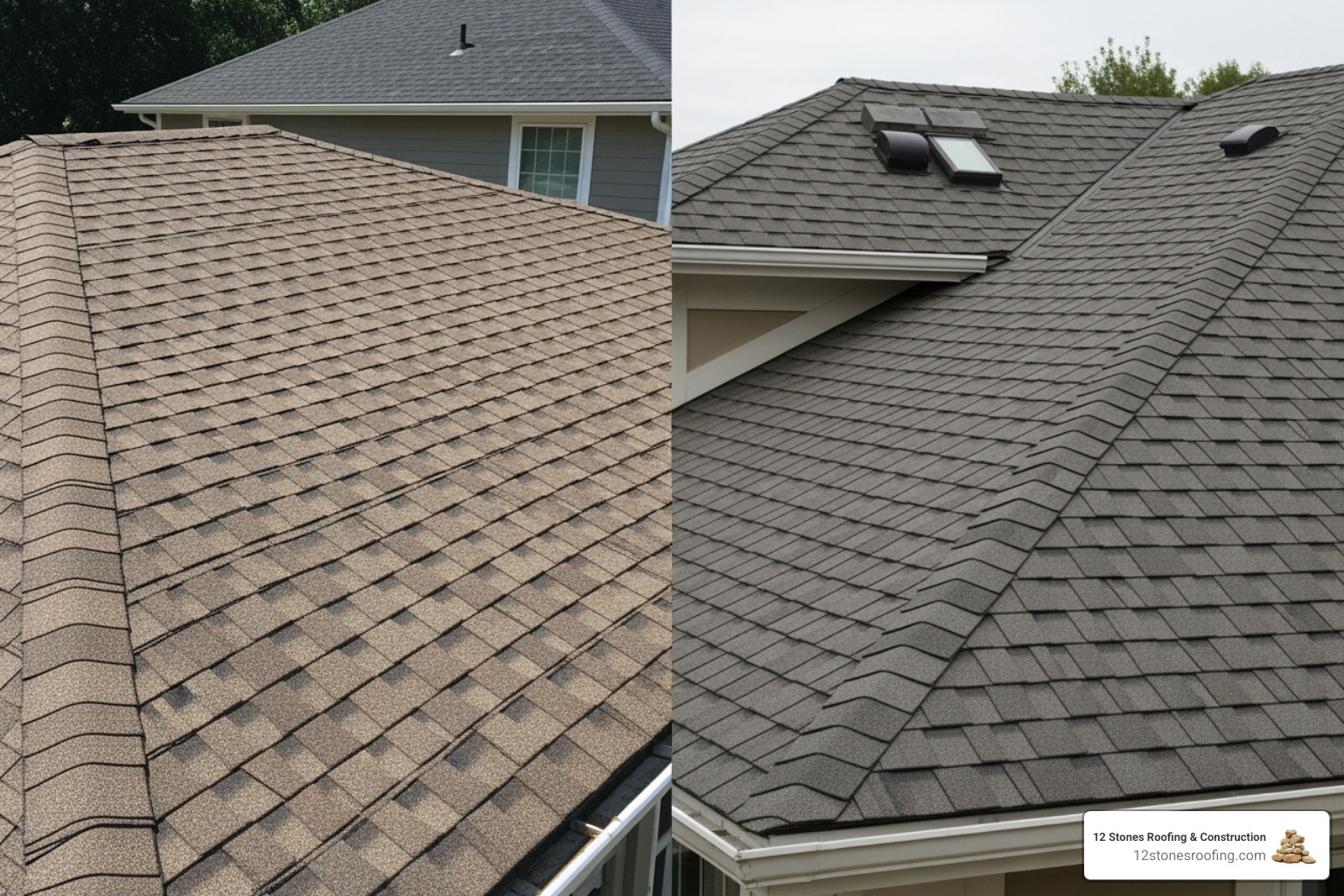
Fiberglass laminate shingles provide a dimensional, textured look that adds depth and character. They can mimic the appearance of expensive materials like natural slate or wood shakes at a fraction of the cost and without the maintenance headaches. This textured surface also helps hide minor imperfections in the roof deck, creating a cleaner finish. The improved curb appeal from architectural shingles is a recognized factor in increasing a home’s market value.
Lifespan and Long-Term Value
Architectural shingles are built to last 30 to 50 years, whereas 3-tab shingles typically have a lifespan of 20 to 25 years. This extended longevity means you may avoid an entire roof replacement cycle over the life of your home.
Manufacturers back this durability with stronger warranties, often offering “Lifetime Limited Warranties” for laminate shingles. These warranties have specific requirements, so understanding the details on roofing warranties is essential. While the upfront cost is higher, the extended lifespan and reduced need for repairs make architectural shingles a more cost-effective choice over the long term.
Cost Breakdown: Upfront Investment vs. Lifetime Protection
While fiberglass laminate shingles have a higher initial cost, they provide better lifetime value.
- Architectural Shingles: $4.00 to $8.50 per square foot installed. For a 2,500 sq. ft. roof, this is roughly $10,000 to $21,250.
- 3-Tab Shingles: $3.50 to $5.00 per square foot installed. The same roof would cost approximately $8,750 to $12,500.
The real value emerges over decades. The superior durability of laminate shingles leads to fewer repair bills. More importantly, their longer lifespan pushes the next full replacement cost—potentially $15,000 to $25,000 or more—farther into the future. When factoring in inflation, the long-term savings are substantial, making laminate shingles a smarter investment for most homeowners.
Professional Installation: Technique Determines Warranty and Wind Rating
The superior performance of fiberglass laminate shingles—including their high wind resistance and watertight seal—is entirely dependent on correct installation. Their weight, thickness, and specific nailing patterns are not suggestions; they are technical requirements that demand professional expertise. A DIY or cut-rate installation will void the manufacturer’s warranty and can turn premium materials into a costly failure.
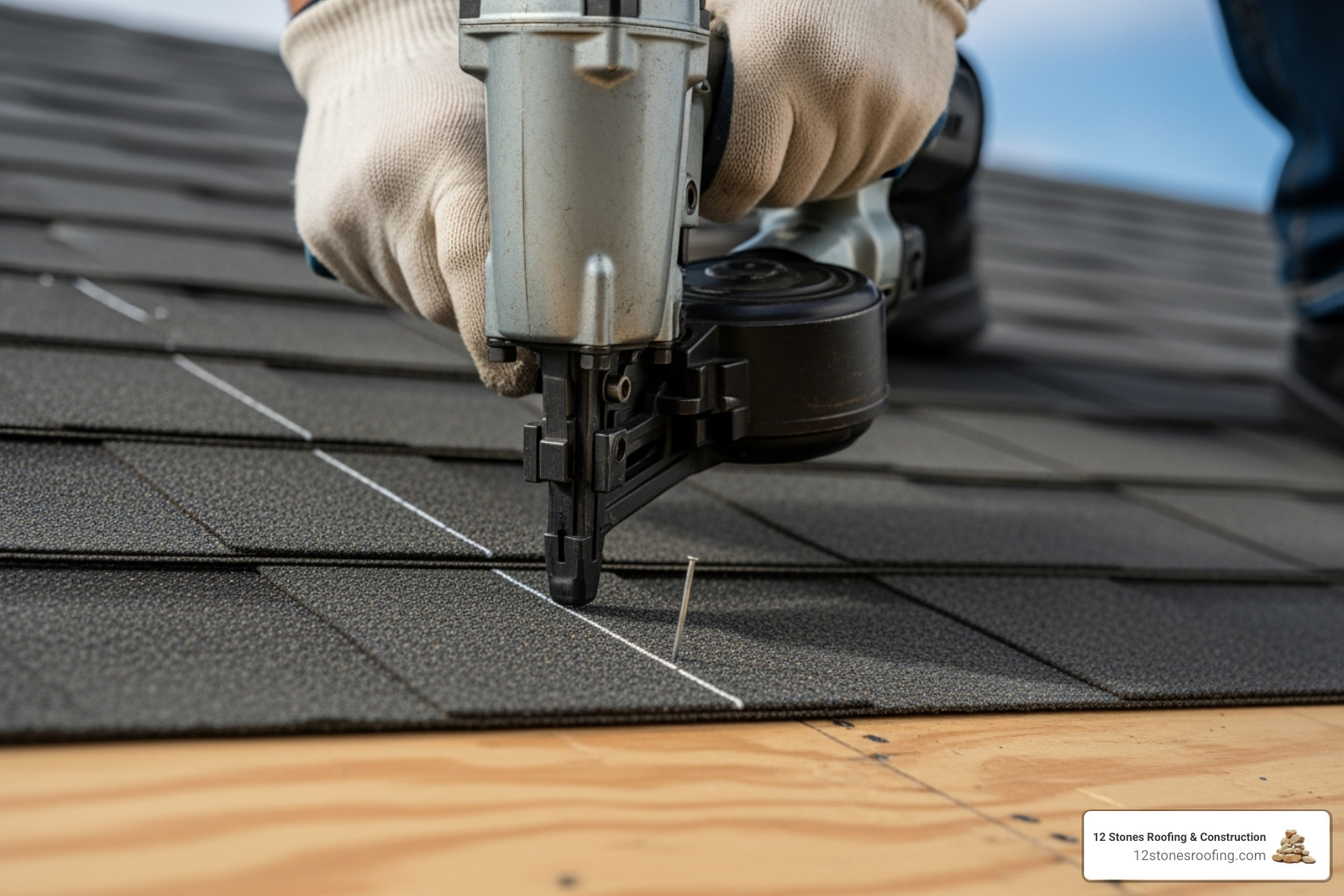
Why Professional Roof Installation is Non-Negotiable
Beyond the inherent dangers of roofing work, installing laminate shingles correctly requires specialized knowledge. Key technical aspects that demand a professional touch include:
- Proper Underlayment & Flashing: A pro ensures a complete secondary water barrier is established, with correctly overlapped underlayment, ice and water shield in vulnerable areas, and properly sealed flashing around chimneys, vents, and in valleys where most leaks occur.
- Correct Nailing Technique: High-wind certification requires a six-nail pattern to qualify for 130 mph limited wind warranties per major manufacturer manuals. Nails must be driven flush within the designated nailing zone to secure both layers of the shingle without tearing it or leaving it vulnerable to wind.
- Ventilation & Warranty Compliance: A balanced attic ventilation system is critical for shingle lifespan and is often a warranty requirement. Professionals ensure that all components—shingles, starter strips, ridge caps, and underlayment—are from the same manufacturer system to keep the warranty intact. Our expert roof installation services guarantee every requirement is met.
Key Steps in a Professional Installation
A professional installation is a systematic process that ensures quality and longevity:
- Tear-Off and Deck Inspection: The old roof is completely removed to allow for a thorough inspection of the underlying roof deck. Any rotted or damaged wood is replaced to create a solid foundation.
- Install Water Barriers: An ice and water shield is applied to eaves, valleys, and around penetrations, followed by a layer of high-quality synthetic underlayment across the entire deck.
- Install Shingles: Starter strips are installed at the edges to prevent wind uplift. The main field of fiberglass laminate shingles is then laid, ensuring proper alignment, overlap, and fastening according to manufacturer specifications.
- Seal and Finish: All valleys, vents, and flashing points are carefully sealed. Finally, specialized ridge cap shingles are installed along the hips and ridges to protect these high-stress areas and complete the roof.
Maintenance Checklist to Reach a 30–50-Year Lifespan
An investment in a high-quality fiberglass laminate shingle roof pays dividends for decades, but routine maintenance is key to achieving its maximum 30 to 50-year lifespan. Proactive care is simple and helps prevent minor issues from becoming major, costly problems.
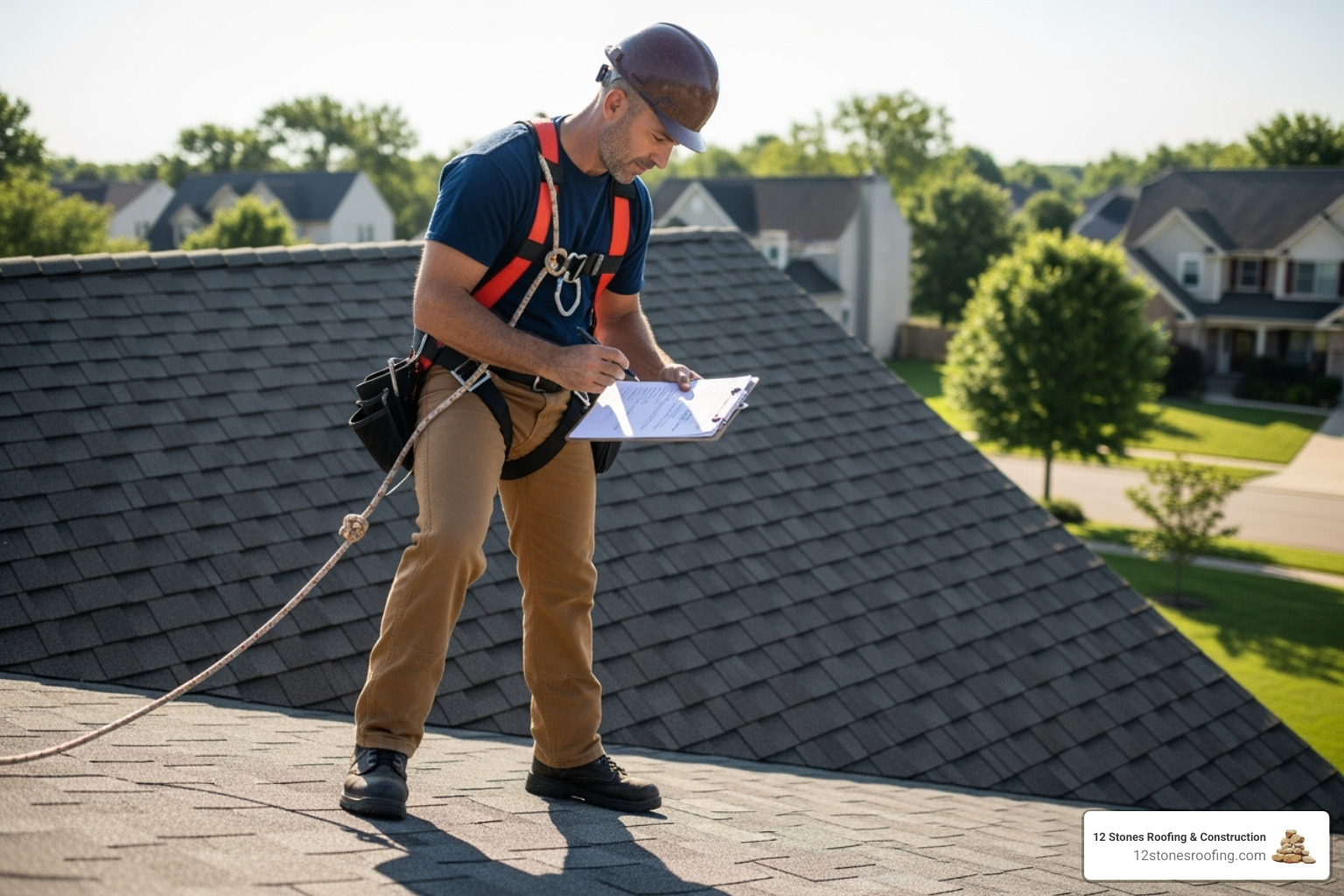
Essential Maintenance Checklist
Performing these simple tasks can significantly extend your roof’s life:
- Regular Inspections: Visually inspect your roof twice a year (spring and fall) and after major storms. Look for missing, cracked, or curling shingles. A professional roof inspection for insurance purposes is also wise after a severe weather event.
- Gutter Cleaning: Keep gutters and downspouts clear to prevent water from backing up under shingles and rotting the roof eaves.
- Debris Removal: Gently remove leaves, branches, and other debris that can trap moisture and promote algae or moss growth.
- Algae and Moss Treatment: While many laminate shingles are algae-resistant, moss can still grow in shaded areas. Moss traps moisture and can lift shingles, so consult a professional for safe removal to avoid damaging the protective granules.
When to Call for a Roof Repair
Don’t wait to call a professional if you notice these warning signs. A quick response can be the difference between a small repair and a full replacement.
- Leaks or Water Stains: Any sign of water on your ceilings or walls requires immediate attention. Leaks can travel, so a professional is needed to trace the source.
- Excessive Granule Loss: While some granule loss is normal on new shingles, finding large amounts in your gutters indicates your shingles are losing their UV protection and aging prematurely.
- Curling or Cracked Shingles: These are clear signs of aging or weather damage. The shingles are no longer providing a waterproof barrier and must be addressed.
- Missing Shingles After a Storm: A bare spot on your roof is a direct entry point for water. This is a common reason for needing prompt and reliable roof repair to prevent serious interior damage.
Conclusion: Why Fiberglass Laminate Shingles Win on Value and Protection
The choice isn’t between fiberglass and laminate, but between two types of fiberglass shingles: basic 3-tab and premium architectural laminate. While 3-tab shingles are an affordable option, architectural fiberglass laminate shingles deliver far superior long-term value. Their improved durability, 30-50 year lifespan, and high-end aesthetic make them a wise investment for homeowners in Pasadena, TX, who face intense sun, heavy rain, and high winds.
Their multi-layered construction offers proven resistance to weather, while their dimensional appearance boosts curb appeal and home value. Though the upfront cost is higher, the extended lifespan and reduced maintenance needs make laminate shingles the more cost-effective solution over the decades, offering peace of mind and lasting beauty.
If you’re ready to upgrade your home’s protection and appearance with a new roof, the experts at 12 Stones Roofing & Construction can help. Learn more about our premier asphalt shingle roofing services to find the perfect solution for your home.



